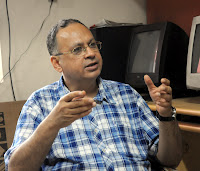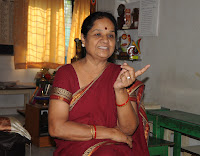Journey of Captain Shantaram Lokhande that started from ‘Ghodegaon Kolona’ village near Pulgaon may soon reach a ‘golden’ destination if the Captain’s brave act of saving a drowning passanger’s life gets him Presidential recognition.
IT WAS quite a windy afternoon in mid June. Conditions in the Bay of Bengal were tough for sailing, especially for a merchant ship. But sailors are trained for such conditions. Rather, they enjoy sailing in challeging situations. Most of the times, the sea allows them to reach coast with a moderate experience of adventure. But, sometimes, it throws bigger challenges.
Motor Vessel ‘Swaraj Dweep’ of Shipping Corporation of India (SCI) was on her way to Andaman from Chennai when a passager came shouting to the bridge that a person has jumped into the sea. High alert was announced and the ship was called for emergency station. Captain Shantaram Lokhande was Master of the ship. As is the culture of Navy that each person and belongings on the ship are the responsibility of the Master; he immediately rushed to the bridge and ordered to turn the vessel to reverse course in search of the missing person. Life buoys, life jackets were thrown at him. Finally, he was holed with the life buoy and was pulled with the heaving line. He was picked up through gangway and was taken to ship’s hospital for first aid.
All this happened within a span of few minutes. The person who monitored the entire operation was Captain Lokhande, our a young man from Vidarbha, who hails from a small village near Pulgaon in Wardha district. After the brave act of rescuing a passager, he is receiving appreciation from one and all. However, for Captain Lokhande, it was just a part of his duty.
“He believes that he has done nothing great. When we talked after the incident, he was as cool as he always is,” said his wife Maya, who lives in Revati Nagar, Nagpur, with their school-going sons Kamod and Mitul. As captain is still on the ship, Lokhande family has kept the grand celebration of his bravery waiting. However, SCI authorities have alredy started preparing for the same - in a different way.
S Hajara, Chairman and Managing Director of SCI, has sent a special letter of appreciation to Captain Lokhande. ‘It demands a great bit of valour and courage to complete such a difficult task in midst of heavy weather. Your exemplary act has set an example for everyone in SCI and you have made us feel proud,’ the CMD says in the letter. It is very likely that Captain Lokhande’s name may be forwarded for the President’s honour.
Apart from his bravery, journey of Captain Lokhande’s life is also inspiring, especially for the young enthusiasts. Hailing from a poor farmer’s family, Shantaram, eldest in four siblings, completed his education combating adverse situations. As a young post graduate in Electronics, he decided to join SCI. He wanted to earn money to get rid of his poverty that had troubled him all his life.
SCI recruits all crews (deck, engine, saloon and GP rating) directly on its main fleet. Apart from a first class in academics, candidate have to be physically fit as per Merchant Shipping Rules.
Shantaram joined as a cadet and later became chief officer and finally a captain. He has served on three ships -- Sagar Sampada, Sagar Kanya, Hrushikesh before joining Swaraj Dweep. The Captain believes that there are ample opportunities for Vidarbha youths if they try some unconventional career options. He is quite keen to impart career guidance to youths.
 |
| Captain Shantaram Lokhande |
IT WAS quite a windy afternoon in mid June. Conditions in the Bay of Bengal were tough for sailing, especially for a merchant ship. But sailors are trained for such conditions. Rather, they enjoy sailing in challeging situations. Most of the times, the sea allows them to reach coast with a moderate experience of adventure. But, sometimes, it throws bigger challenges.
Motor Vessel ‘Swaraj Dweep’ of Shipping Corporation of India (SCI) was on her way to Andaman from Chennai when a passager came shouting to the bridge that a person has jumped into the sea. High alert was announced and the ship was called for emergency station. Captain Shantaram Lokhande was Master of the ship. As is the culture of Navy that each person and belongings on the ship are the responsibility of the Master; he immediately rushed to the bridge and ordered to turn the vessel to reverse course in search of the missing person. Life buoys, life jackets were thrown at him. Finally, he was holed with the life buoy and was pulled with the heaving line. He was picked up through gangway and was taken to ship’s hospital for first aid.
All this happened within a span of few minutes. The person who monitored the entire operation was Captain Lokhande, our a young man from Vidarbha, who hails from a small village near Pulgaon in Wardha district. After the brave act of rescuing a passager, he is receiving appreciation from one and all. However, for Captain Lokhande, it was just a part of his duty.
“He believes that he has done nothing great. When we talked after the incident, he was as cool as he always is,” said his wife Maya, who lives in Revati Nagar, Nagpur, with their school-going sons Kamod and Mitul. As captain is still on the ship, Lokhande family has kept the grand celebration of his bravery waiting. However, SCI authorities have alredy started preparing for the same - in a different way.
S Hajara, Chairman and Managing Director of SCI, has sent a special letter of appreciation to Captain Lokhande. ‘It demands a great bit of valour and courage to complete such a difficult task in midst of heavy weather. Your exemplary act has set an example for everyone in SCI and you have made us feel proud,’ the CMD says in the letter. It is very likely that Captain Lokhande’s name may be forwarded for the President’s honour.
Apart from his bravery, journey of Captain Lokhande’s life is also inspiring, especially for the young enthusiasts. Hailing from a poor farmer’s family, Shantaram, eldest in four siblings, completed his education combating adverse situations. As a young post graduate in Electronics, he decided to join SCI. He wanted to earn money to get rid of his poverty that had troubled him all his life.
SCI recruits all crews (deck, engine, saloon and GP rating) directly on its main fleet. Apart from a first class in academics, candidate have to be physically fit as per Merchant Shipping Rules.
Shantaram joined as a cadet and later became chief officer and finally a captain. He has served on three ships -- Sagar Sampada, Sagar Kanya, Hrushikesh before joining Swaraj Dweep. The Captain believes that there are ample opportunities for Vidarbha youths if they try some unconventional career options. He is quite keen to impart career guidance to youths.
 |
| Cutting of the same article that appeared in The Hitavada's Sunday, October 7 CityLine Edition |


















 'Theatre Around' my new weekly column started in a special 'Sunday Sundae' suppliment of 'The Hitavada' Nagpur CityLine, from May 13. This column aims to highlight the contribution of non-Marathi theatre activity in Nagpur city's Fine Art scene. It started with an overview of Bengali Theatre, led by noted producer-director Raja Mukherjee. Here is the first part published on May 13, 2012....
'Theatre Around' my new weekly column started in a special 'Sunday Sundae' suppliment of 'The Hitavada' Nagpur CityLine, from May 13. This column aims to highlight the contribution of non-Marathi theatre activity in Nagpur city's Fine Art scene. It started with an overview of Bengali Theatre, led by noted producer-director Raja Mukherjee. Here is the first part published on May 13, 2012....




